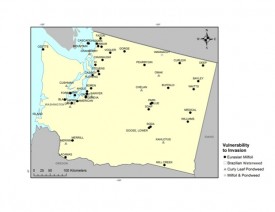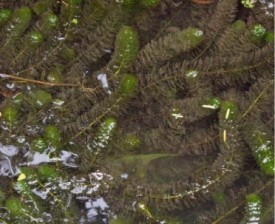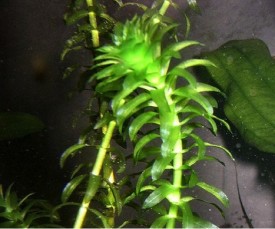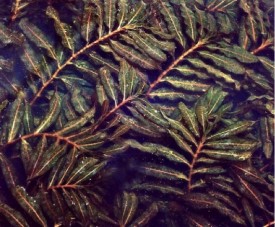by Julian Olden, University of Washington
 Prevention is key to managing aquatic invasive species, yet is highly challenging when the landscapes to be managed include thousands of lakes, multiple invasive species, and limited resources for action.
Prevention is key to managing aquatic invasive species, yet is highly challenging when the landscapes to be managed include thousands of lakes, multiple invasive species, and limited resources for action.
Julian Olden and his colleagues at the University of Washington recently developed statistical models to help prevention efforts by identifying the locations most vulnerable to future invasion based on the likelihood of introduction and establishment. The study – funded by the Washington Department of Ecology – assessed the vulnerability of lakes across Washington to invasion by three noxious plants – Eurasian milfoil (Myriophyllum spicatum), Brazilian waterweed (Egeria densa), and curly leaf pondweed (Potamogeton crispus).
Overall, the models predicted that about a fifth (54 of 319) of the lakes studied are at risk of invasion by at least one aquatic invasive plant (see graphic above). Some of the lakes at risk of invasion currently support diverse native plant populations.
Highly vulnerable lakes are concentrated in western Washington, in places with high densities of humans, and in eastern Washington along the Columbia Basin Irrigation Project and the Okanogan River Basin where hundreds of lakes are used for recreation. Overall, invasion potential for the three species was highly predictable as a function of attributes describing human accessibility (e.g., public boat launch, urban land use) and physical–chemical conditions (e.g., lake area, elevation, productivity, total phosphorous).
By identifying highly vulnerable lake ecosystems, this study offers a strategy for prioritizing on-the-ground management and shaping the most efficient allocation of resources to minimize future plant invasions in Washington. Surveillance of the 50+ vulnerable lakes is paramount to prevent new invasions. Early detection and rapid response strategies are also required to eradicate and control early infestations discovered by lake monitoring. These strategies can reduce the risk of heavy infestation and may even lead to successful eradication.
Education is also critical in preventing invasions. Specifically, signage explaining how to stop the spread of invasive species should be posted at public parks and boat launches on all vulnerable lakes. Note that this would be a departure from the current management strategy in Washington (and most other states) where signage is only posted on lakes already infested.
Lastly we need a better understanding of dispersal vectors – how do these plants spread? Currently, there is limited information about aquarium disposal and inland boater traffic in Washington. These two vectors warrant further research as they will help identify invasion hubs and other vulnerable waterbodies across the state.
For more information, contact Julian Olden (e-mail: olden@uw.edu; Twitter: @oldenfish) or visit http://www.fish.washington.edu/research/oldenlab.












